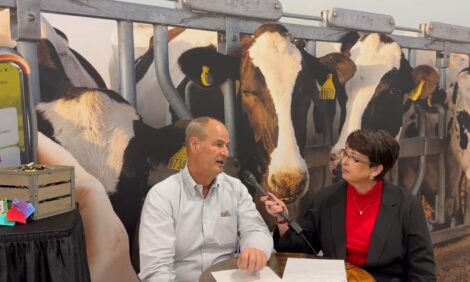



What is Mastitis Costing You?
Mastitis costs dairy farms more than any other disease. Control clinical and subclinical infections to improve milk quality and boost profitability, writes Amber Yutzy, Penn State Dairy Extension Educator.
In the environment of today's dairy industry, producers need to evaluate all areas of the farm to control costs and achieve optimum profitability. One way to control costs is by minimizing the rate of disease in your herd. The costliest disease found on dairy farms is mastitis. Mastitis can cause both clinical and subclinical disease. On many farms, subclinical mastitis is the most economically important type of mastitis. This is due to the long-term effect of chronic infections on total milk yield throughout the entire lactation. Persistent long-term infections with contagious pathogens can damage milk secretory cells and result in reduced milk production. It is estimated that the cost of subclinical mastitis to the US dairy industry exceeds $1 billion annually (Ott, 1999).
The effects of subclinical mastitis are found in somatic cell counts of the bulk tank and individual cow tests. The SCC of cows infected with subclinical mastitis rises as the cow's immune system sends white blood cells to the udder to fight off mastitis causing pathogens. The overall production loss for the average US dairy farm is estimated at $110/cow annually and increasing each year. Improving milk quality is important for every farm looking to boost profitability.
High SCC milk is not desirable for milk processors because it reduces the shelf life of dairy products and diminishes the quality and quantity of milk protein, in return reducing cheese yields. It has been shown that cheese yields from an individual cow are affected when SCC exceeds 100,000 cells/mL. Cheese yields of milk comingled from a group of cows are impacted more by the proportion of cows with SCC >100,000 cells/mL than by the bulk tank SCC average.
Most milk cooperatives pay premiums for higher quality milk. In the past year producers have seen these premiums slowly erode, but achieving the highest premium available can make or break some dairies. Quality premiums are a great opportunity for producers to increase profitability and are one of the few ways to impact the price paid for milk. Farms that are not maximizing this opportunity are missing out on an important source of income.
Controlling subclinical mastitis and producing lower SCC milk represents a potential profit opportunity associated with both increased production and increased milk price through premiums. Most farms can justify an investment in improving their milk quality program, simply by the return of real dollars in quality premiums.
Somatic cells in milk consist of white blood cells and epithelial cells that are shed from the udder. When the cow's udder becomes inflamed, her immune system sends large numbers of white blood cells to fight off the infection. A SCC >200,000 indicates that the cow has a subclinical mastitis infection. Linear score (LS) is another way to measure SCC. Research has shown that LS is highly related to loss of milk production in infected cows. Loss of milk production is the result of damage and chronic scarring of milk secretory tissue in the udder. Linear score data can be used to estimate milk production losses due to subclinical mastitis. Each increased unit of LS greater than the farm goal equates to an annual loss of 200 pounds of milk for first lactation animals or 400 pounds for older animals. Improvements in subclinical mastitis are not always as easy to see as increased milk quality premiums, but considerable improvement in production is possible by limiting the number of subclinical mastitis infections on your farm.
Clinical mastitis can also cause financial loss for a dairy farm. The cost of clinical mastitis is often difficult to determine because the definition of a clinical case varies among employees and between farms. Treatment protocols vary, and many farms do not routinely record the number of clinical cases that occur. The largest cost of clinical cases is typically discarded milk. On many dairies the cost of discarded milk can be a considerable, hidden cost of clinical mastitis. Cows that are chronically infected and treated repeatedly contribute less milk to the bulk tank. Keeping records of the number of clinical cases of mastitis and the number of days milk was discarded can be important in achieving optimum profitability. A cow is not profitable to your farm unless she produces milk that can be sold.
Lost premium opportunities, decreased milk production, and discarded milk are only some of the total costs associated with mastitis on most dairy farms. Mastitis causes additional losses due to death, culling, decreased genetic gain, and reductions in reproductive efficiency. These additional costs are often difficult to track on an individual farm. Keeping accurate on-farm records of clinical mastitis cases and treatment methods and testing SCC monthly will help you develop a more accurate picture of what mastitis truly costs. Don't wait; tackle milk quality issues now!
Contact your local Penn State Extension Dairy Educator to help you trouble shoot and make your farm more profitable.
ReferencesBarbano, D. M., R. R. Rasmussen, J. M. and Lynch. 1991. Influence of milk SCC and milk age on cheese yield. J. Dairy Sci. 74:369-388.
Ott, S. 1999. Costs of herd-level production losses associated with subclinical mastitis in US Dairy Cows. Pages 152-156 in Proc. 38th Ann. Mtg. Natl. Mastitis Counc., Arlington, VA. Natl. Mastitis Counc., Madison, WI.
Raubertas, R. F., and G. E. Shook. 1982. Relationship between lactation measures of somatic cell concentration and milk yield. J. Dairy Sci. 65:419-425.


